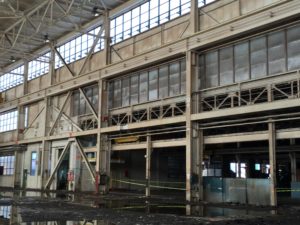Celebrating 5 Years – Climate Change & COP21
It’s been five years since I launched Barbara A. Campagna/Architecture + Planning, PLLC and while many things have changed, my goal to work on “greening what’s already here” continues to be met, often in places I never expected. Many people are finding new ways to integrate historic preservation and green building practices, which makes my venture a delightful and intellectually inspiring one. This is blog ONE of my 5th anniversary week.
I was interviewed for an article in Architect Magazine about COP21 by Kim O’Connell, which got me thinking about how far the new Paris Climate agreement goes. That seems to be a good place to start my week of celebration blogs – as this could impact everything I do, and all architects do.
What is your general response, as an architect and a sustainability leader, to the Paris Climate Agreement? Did it go far enough?

The United Nations from Long Island City. The Secretariat’s curtain wall was replaced with a more efficient one.
In some respects the Paris Climate Agreement is the most exciting thing to happen to sustainability since the 1987 Brundtland Commission’s release of “Our Common Future.” In other respects, it could barely take us beyond the status quo. But what I find really significant about the agreement is that there WAS an agreement between all 196 countries including the US and China. There was discussion. It’s carnival atmosphere captured the attention of the whole world. The agreement which basically provides the framework to keep world-wide warming to two degrees and if possible to 1.5 degrees sends a signal to the world and to corporations. It says that this is serious; we need to pay attention. It should spur re-investment in renewables. It provides recommendations to create guidelines in capacity building and transparency. Politically, we have till 2018 and 2023 to make this all happen, but will enough countries actually ratify it? Will the US ratify it? It will all depend on the fall presidential election.
Architects have already committed to the 2030 carbon neutrality challenge. Is this a sufficient goal in light of the Paris Agreement? Are enough architects doing their part?

Manhattan from the 54th floor of 54 Leonard, the new Herzog & DeMeuron residential tower in TriBeCa.
While Architecture 2030 has lofty goals and well-detailed recommendations, it is primarily being adopted by large cities, large firms, large agencies. As someone who works in both big cities and medium/small cities, the disparity between sustainability efforts is huge. Few architects and owners apply real, meaningful sustainability efforts to projects unless they are required by the client or the jurisdiction. Building and zoning codes that require LEED for example (such as Chicago, Washington, DC, Washington State) are far more effective in ensuring at least a base level of sustainable approaches. While New York State and New York City do not currently have legislation that requires LEED, the new benchmarking laws for all buildings over 50,000 square feet are making a big impact.
Does the 2030 Commitment have enough “weight” and exposure in terms of galvanizing architects and the general public to greater awareness?
I do not believe that a “commitment” that is basically primarily focused on architects can promote greater public awareness. It needs to be retooled in a way that the average person, who may not even know an architect, but cares about recycling or saving energy costs, can readily understand it and feel like it impacts their life. Tax credits for solar – that impacts public awareness. Signing up to meet the 2030 Challenge – that does not impact public awareness.
How will COP21 affect what the profession is doing? What more can it do to promote energy efficiency and sustainability?

The former Niagara Machine and Tool Company factory complex at 683 Northland Avenue on the East Side of Buffalo is set to be adapted into a net zero mixed use property.
COP21 will have to affect the architectural profession. Since almost 50% of all greenhouse gas emissions can be traced to construction activities, in order to meet the goals of limiting warming to 1.5 or 2 degrees, every building activity will matter. We can only meet these goals (which still may not be rigorous enough) if the leaders in the architecture and construction fields are integral to developing these approaches.
And if you’d like to “subscribe” or follow my blog, True Green Cities please sign up through the “Subscribe” button at the bottom left of this page. You’ll receive a daily recap when new blogs are posted. Or Sign up for the Feed.

